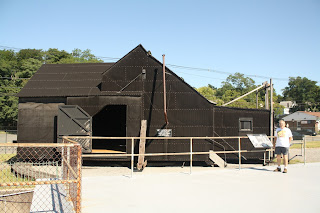SUMMER TRAVELS-- New York 2015
When it came time to take Tara to Newark Airport for a flight south, we had another opportunity to do some sightseeing. Andy had planned our trip to New Jersey as a day of touring once we left the terminals. With Tara safely ushered inside, it was on to Thomas Edison's library and complex in West Orange, New Jersey for us.
 |
| The factory Library is a place of intellectual magnificence. |
 |
| Nestled between shelves of rare books in the library is Edison's bed. |
 |
| In this lab Thomas Edison perfected the light bulb. |
"Grand science--chemistry," Edison once said. "I like it best of all the sciences."
Beginning in the late 1890's, Edison and his staff worked for more than a decade to develop a practical storage battery for electric automobiles. After thousands of experiments, they produced a nickel-iron-alkaline battery by 1909. Although not practical for electric autos, Edison's durable battery was used for industry, mining and railroad applications. And it was actually invented in this lab more than a hundred years ago.
 |
| The old factory was clean and polished. |
Three complete floors of memorabilia filled every inch of the old lab building, with moving displays and sound bites. We could have spent days just reading all the information.
The adjoining buildings gave us peaks into life on Thomas Edison's "campus."
Metals were vital to Thomas Edison--from iron, copper and various alloys used in new inventions to gold for plating phonograph record molds. In the adjoining metallurgical laboratory, workers collected, assayed and evaluated the metals used for Edison's projects.
In the late 1890's Edison employees experimented with the magnetic extraction of iron from low-grade ore. But by 1900, discovery of high-grade ore deposits dashed Edison's hope of making a profit from milling New Jersey's low-grade ores. After losing millions, Edison stated, "Well, it's all gone, but we had a good time spending it!"
 |
| In excellent condition, Edison's main factory stands as a tribute to scientific experimentation and industrial development. |
Finally we reached the outdoor pavilion adjoining the Black Maria. It was set up with a large tent for outdoor entertainment. In 1893 the Black Maria became the world's first building constructed as a motion picture studio. The odd-shaped structure was designed to keep sunlight on the stage while Edison's pioneers made kinetoscope films.
 |
| The first ever movie studio, The Black Maria rotates to capture sunlight during filming. |
An early sound picture from 1894 showed Edison's chief motion picture assistant playing violin while two men danced. The kinetophone, a "talking pictures" system, was introduced by Edison in 1912, but it proved unreliable and was soon abandoned. Practical sound film was not achieved until the late 1920's.
 |
| Edison's parlor offers understated elegance of upper class living. |
 |
| The Thomas Edison mansion of West Orange, New Jersey offers spacious lawns and gardens at the top of the hill. |
Following Andy's map and my own GPS know-how, we found our way to Paterson, New Jersey to the Paterson Great Falls.
 |
| Even in a dry summer, Paterson Great Falls puts on a display. |
 |
| Located downtown, the park is currently being upgraded. |
 |
| Trails follow both sides of the waterway. |
 |
| No swimming allowed here, but the scenery is lovely. |
No comments:
Post a Comment